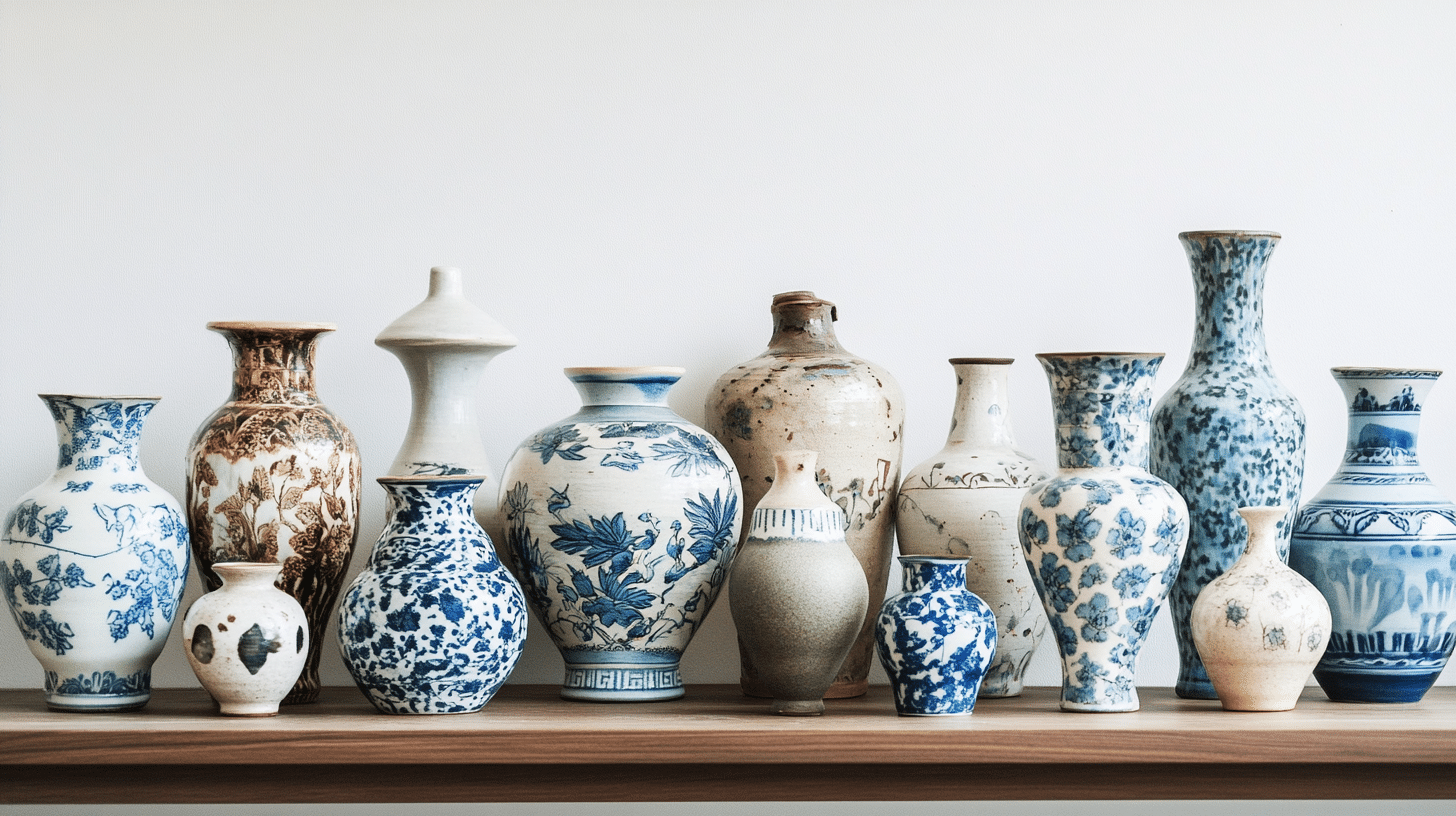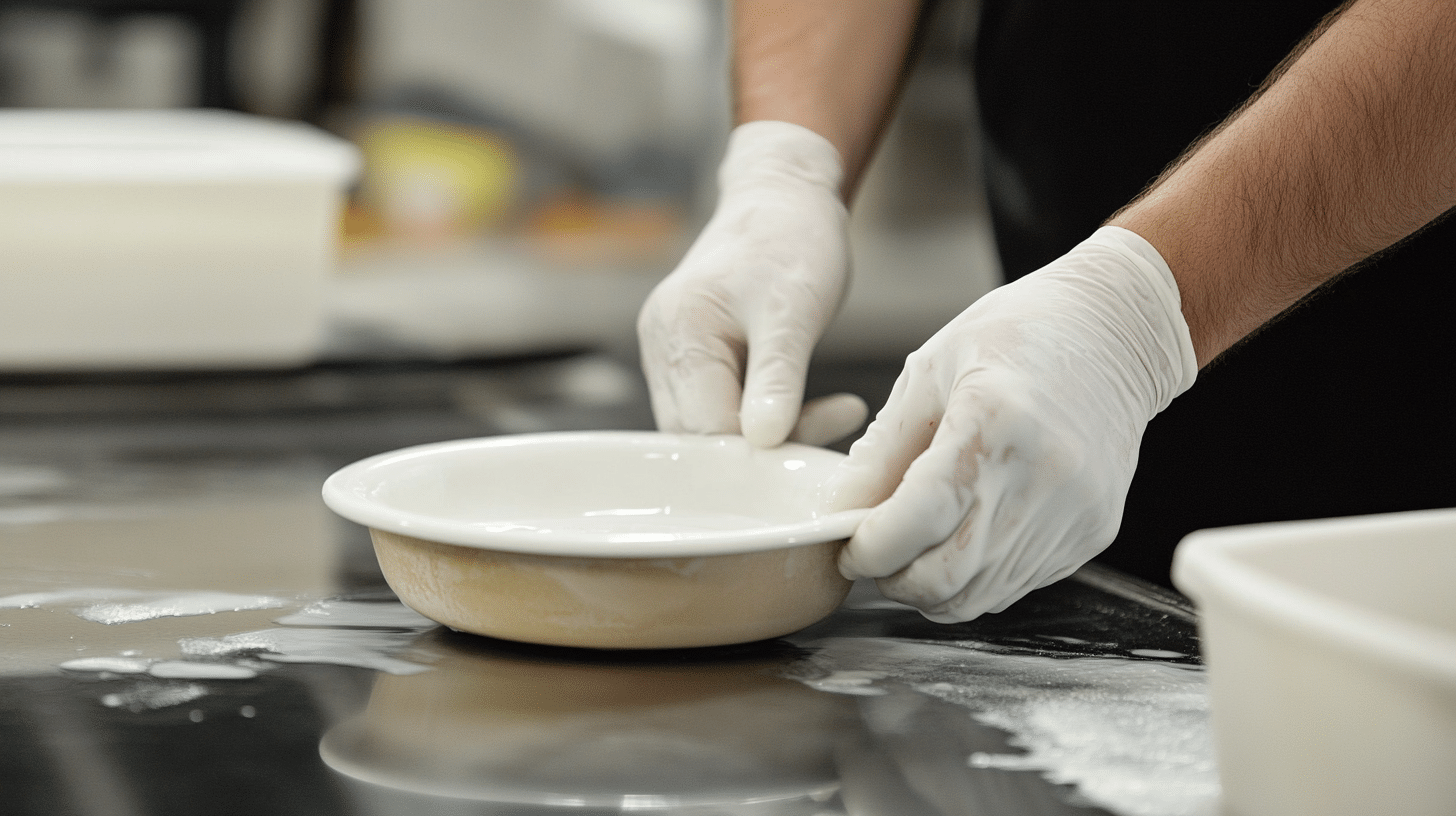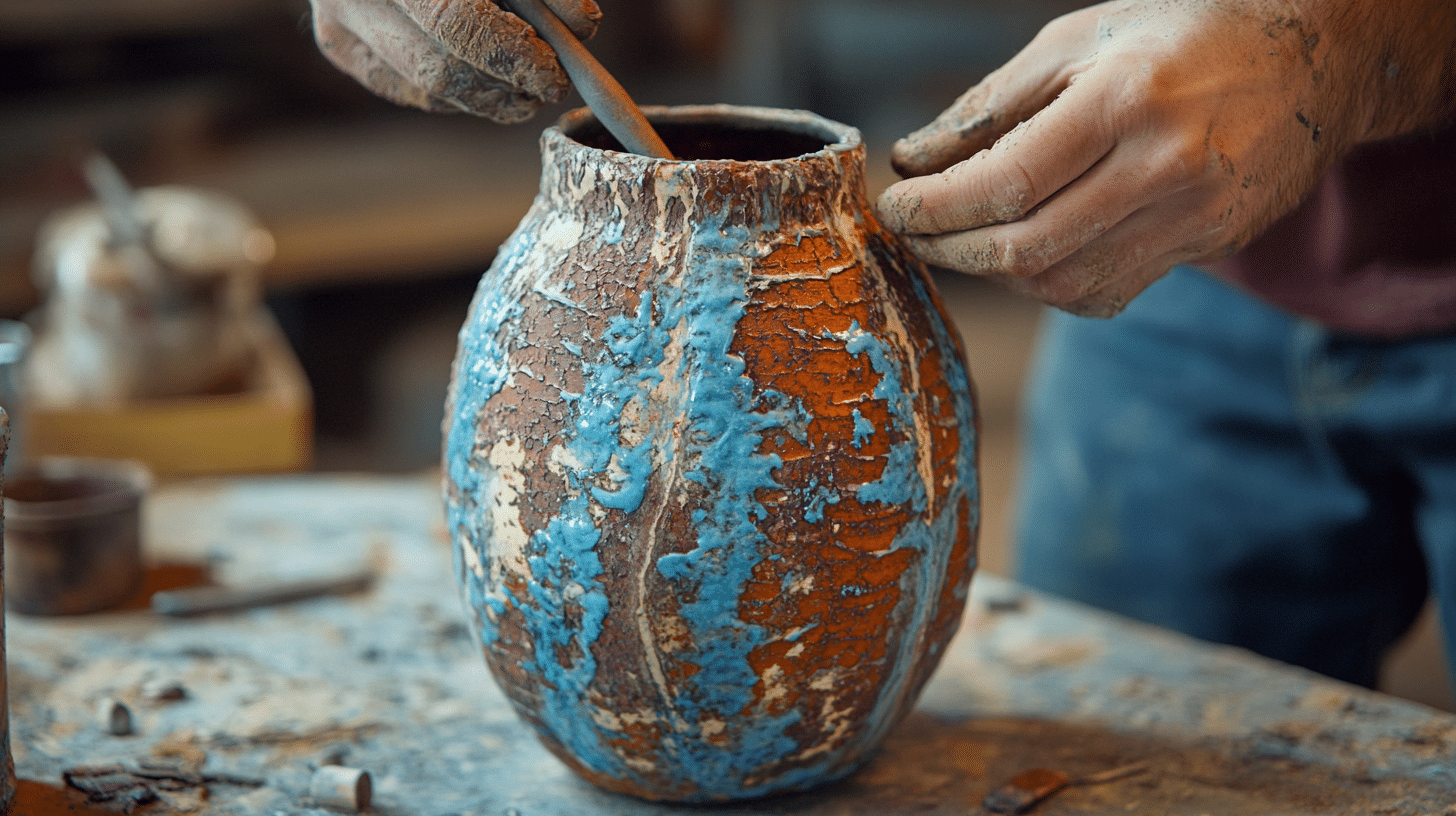Transform ordinary vessels into stunning centerpieces that tell your unique story. Imagine creating designer-worthy vases that become instant conversation starters, perfectly matching your home’s look while expressing your creative vision.
The secret? Simple materials like joint compounds, wood dowels, and paint can elevate basic pieces into art worthy of high-end boutiques.
Whether you prefer modern Scandinavian style, rustic farmhouse charm, or graceful old-world designs, these DIY techniques work with any decor theme.
Ready to join countless crafters who’ve discovered the satisfaction of making custom vases? This guide breaks down multiple methods, from quick weekend projects to more detailed creations, helping you choose the perfect technique for your skill level and style preferences.
Understanding Vase Making
The Beauty of Handcrafted Vessels
Creating your vases brings a unique sense of accomplishment while adding personal touches to your living space.
Whether you’re looking to match specific decor or explore your creativity, handmade vases offer endless possibilities for customization and expression.
Why Choose DIY Vases?
Beyond the satisfaction of crafting something beautiful with your own hands, making vases allows you to save money while creating pieces that perfectly match your vision.
You control every aspect of the creative process, from modern minimalist designs to rustic farmhouse styles.
Essential Materials and Tools
1. Basic Supplies
A successful vase project starts with the right materials. Your basic toolkit should include:
- Glass or ceramic vessels for upcycling
- Joint compound or drywall compound
- Various paints (chalk, acrylic, or latex)
- Wood dowels for modern designs
- Mesh drywall tape
- Hot glue and adhesives
- Sandpaper in multiple grits
- Protective sealants
2. Required Tools
Ensure you have these tools before starting:
- Putty knives in various sizes
- Quality paintbrushes
- Basic crafting tools
- Measuring implements
- Cleaning supplies
3. Safety Guidelines
Always prioritize safety when crafting:
- Work in well-ventilated areas
- Use appropriate protective gear
- Keep materials away from children and pets
- Store supplies properly
- Clean work surfaces thoroughly
Step-by-Step DIY Vase Building Guide
STEP 1: Selecting Your Base
Choose a vessel that matches your desired result. Consider size, shape, and current texture. Thrift stores offer excellent options for glass and ceramic bases, while craft stores provide new materials for specific designs.
STEP 2: Surface Preparation
Clean your chosen vessel thoroughly with soap and water. Remove any stickers or labels using warm water or adhesive remover. Sand glossy surfaces lightly to help new materials adhere better.
STEP 3: Adding Base Texture
Apply your chosen texturing material. For stone effects, use mesh tape covered with joint compound. For modern looks, arrange wood dowels vertically. Ensure even coverage and let each layer dry completely.
STEP 4: Building Character
Create depth and interest through multiple layers of texture. Use tools to create patterns or add additional materials for unique effects. Allow proper drying time between applications.
STEP 5: Initial Paint Application
Apply your base coat of paint, choosing colors that complement your final vision. Dark base colors work well for aged looks, while lighter bases suit modern designs.
STEP 6: Detail Work
Add dimension through specialized painting techniques:
- Dry brushing for texture highlights
- Color layering for depth
- Distressing for aged appearances
- Pattern work for specific themes
STEP 7: Finishing Touches
Seal your work with appropriate products to ensure longevity. Add any final embellishments or decorative elements after sealing.
Creative Vase Decorating Techniques
1. Modern Painting Approaches
Transform simple vessels using these contemporary techniques:
- Ombre effects for gradient looks
- Color blocking for bold statements
- Metallic accents for luxury touches
- Textural effects using specialty paints
2. Texture Creation Methods
Build interest through various texturing approaches:
- Compound techniques for stone effects
- Wood elements for natural looks
- Fabric incorporation for soft textures
- Mixed media for unique results
3. Innovative Material Usage
Think beyond traditional supplies:
- Concrete for industrial styles
- Metal elements for modern designs
- Natural materials for organic looks
- Recycled elements for eco-friendly pieces
Seasonal and Themed Vases
Winter Wonderland Designs
Create frost-inspired pieces perfect for cold months:
- Use crystal effects for icy appearances
- Incorporate metallic elements for holiday sparkle
- Add texture for snow-like surfaces
- Choose cool color palettes
Spring Revival Collection
Celebrate new growth with fresh designs:
- Implement floral patterns
- Use pastel color schemes
- Add natural elements
- Create light, airy textures
Summer Coastal Creations
Bring beach vibes indoors:
- Incorporate sand textures
- Use ocean-inspired colors
- Add rope or twine elements
- Create wave-like patterns
Autumn Harvest Styles
Welcome fall’s warm aesthetic:
- Use earth-tone palettes
- Add leaf impressions
- Create bark-like textures
- Incorporate metallic accents
Eco-Friendly and Sustainable Vase Projects
1. Upcycling Innovations
Transform existing items into beautiful pieces:
- Convert glass bottles
- Repurpose ceramic containers
- Update plastic vessels
- Refresh metal containers
2. Natural Material Integration
Incorporate earth-friendly elements:
- Use found driftwood
- Add pressed flowers
- Include stone elements
- Integrate dried botanicals
3. Sustainable Crafting Practices
Minimize environmental impact:
- Choose eco-friendly paints
- Use natural sealants
- Opt for biodegradable materials
- Practice zero-waste techniques
Troubleshooting Common Issues With Vases
Paint Problems
Address common painting challenges:
- Peeling prevention
- Proper adhesion techniques
- Even coverage methods
- Texture consistency
Material Bonding
Ensure lasting results:
- Choose appropriate adhesives
- Prepare surfaces properly
- Allow adequate drying time
- Test combinations first
Surface Fixes
Correct common issues:
- Smooth uneven textures
- Fix bubbling surfaces
- Repair cracks
- Address paint drips
Professional Vase Enhancement Tips
1. Design Principles
Create balanced compositions:
- Consider proportions
- Plan color schemes
- Balance textures
- Create focal points
2. Finishing Techniques
Achieve professional results:
- Layer materials properly
- Sand between coats
- Apply even finishes
- Seal effectively
3. Display Strategies
Showcase your creations:
- Group similar styles
- Create height variation
- Consider lighting
- Plan seasonal rotations
Floral Arrangement Basics for Vases
Flower Selection
Choose appropriate blooms:
- Match flower size to vase
- Consider stem length
- Plan color combinations
- Account for seasonal availability
Arrangement Techniques
Create stunning displays:
- Position flowers properly
- Layer different heights
- Balance colors and textures
- Maintain proper water levels
Long-lasting Displays
Extend arrangement life:
- Change water regularly
- Trim stems properly
- Remove dying blooms
- Use flower preservatives
Cultural and Historical Context of Vases
1. Historical Significance
Understanding vase evolution:
- Ancient pottery origins
- Cultural influences
- Traditional techniques
- Modern adaptations
2. Contemporary Trends
Current style movements:
- Minimalist designs
- Organic forms
- Mixed material use
- Sustainable approaches
3. Future Directions
Emerging trends:
- New material combinations
- Innovative techniques
- Technology integration
- Sustainable practices
Vase Care and Maintenance
Cleaning Methods
Maintain your creations:
- Use appropriate cleaners
- Handle with care
- Store properly
- Protect from damage
Preservation Techniques
Extend vase lifespan:
- Avoid harsh conditions
- Protect from direct sunlight
- Handle with clean hands
- Repair minor damage promptly
Display Tips
Maximize visual impact:
- Rotate seasonal displays
- Group complementary pieces
- Consider lighting effects
- Change arrangements regularly
Fun Facts Related to Vases
-
Ancient Origins: Vases date back to 4,000 BCE in Mesopotamia, where they were used for storage, decoration, and rituals.
-
Greek Influence: Ancient Greeks popularized vases with intricate designs, often depicting mythological scenes and daily life, which inspired vase styles worldwide.
-
Symbol of Wealth: In the Ming Dynasty, porcelain vases became symbols of wealth and status, sought after by collectors globally.
-
Cultural Symbolism: In Japan, the art of Ikebana (flower arranging) places vases as central, symbolizing harmony and balance with nature.
-
Eco-Friendly Renaissance: Vases made from recycled glass, clay, and bamboo today reflect a growing focus on sustainability in home decor.
Conclusion
Remember, creating beautiful vases is a voyage of exploration and creativity. Start with simpler projects and gradually build your skills.
Each piece you create will help you develop your unique style and technique. Most importantly, enjoy the process of bringing your artistic vision to life.
This comprehensive guide provides a foundation for both beginners and experienced crafters. Feel free to adapt these techniques to match your style and creative goals.
Frequently Asked Questions (FAQs)
What Kind of Paint Do You Use on a Vase?
Acrylic paint works well on most vases and provides vibrant colors. For a lasting finish, consider spray paint designed for glass or ceramics and seal with a clear coat.
How Do You Make Fake Water in a Vase?
To create fake water, use clear resin or epoxy. Mix and pour it into the vase, allowing it to harden. This gives artificial flower arrangements a realistic water-like appearance.
How Do I Achieve a Textured Finish on a Vase?
Apply texture paste or baking soda mixed with paint, or use materials like sand and fabric. These can be brushed or sponged onto the vase to create various textured effects.
What Are Some Eco-Friendly Materials for Vase-Making?
Eco-friendly materials include recycled glass, bamboo, driftwood, clay, and natural stones. These sustainable options reduce environmental impact and add unique textures and character to your vases.

























